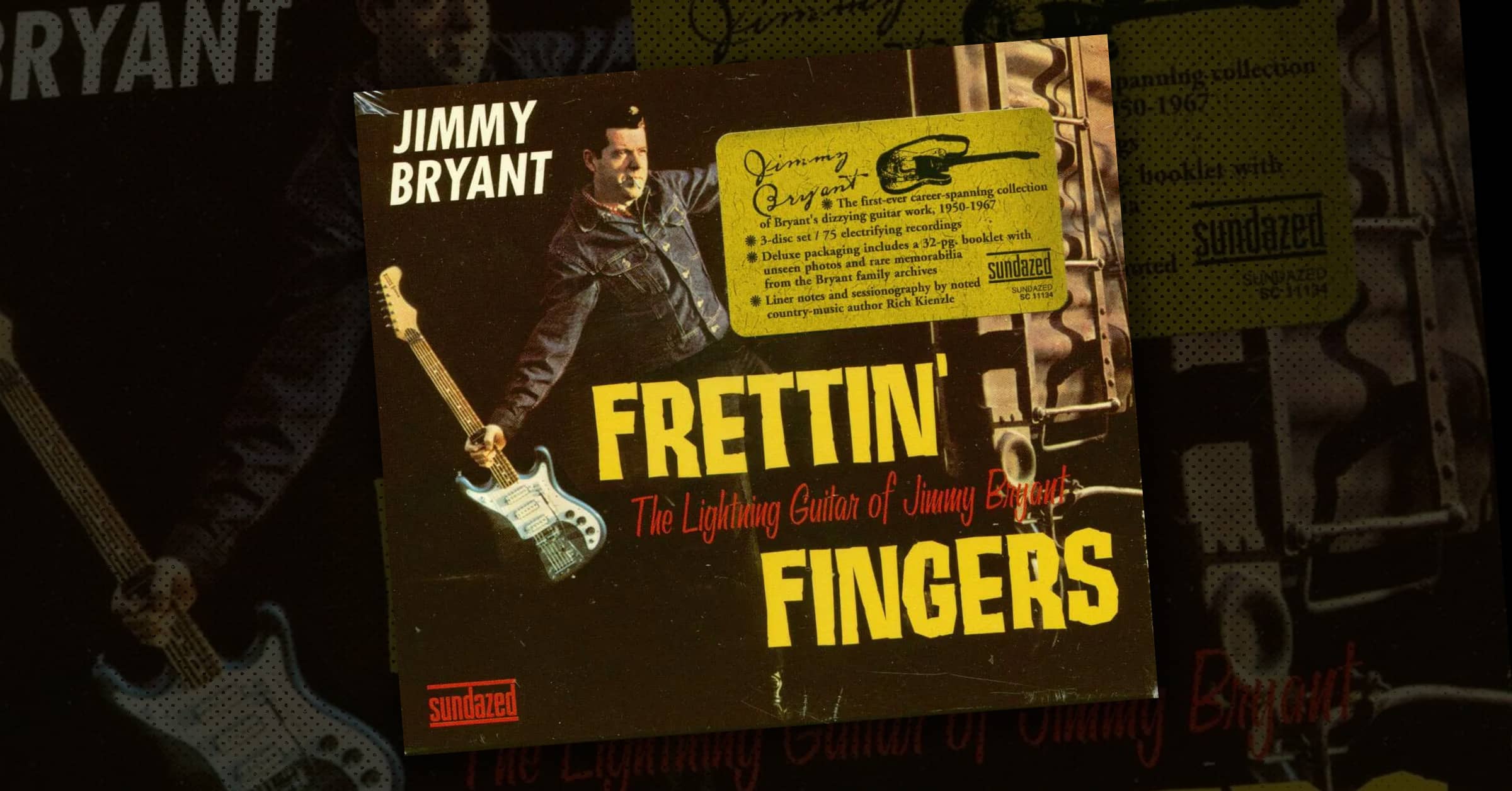Sundazed Records, August 2003
Just remember: IT’S ALL IN THE HANDS. Jimmy Bryant could take a hollow log with barbed wire attached and make it sound great. That being said, let’s examine some of the equipment that gave him his signature tones.
When Jimmy first moved to Los Angeles in the late ‘40s, he was playing a hollowbody Gibson Super 400 with a floating DeArmond pickup. This is probably the guitar heard on some of the early session work such as “Wild Card” by Tex Williams.
It wasn’t long, however, before Bryant hooked up with Leo Fender, and as early as 1950 or 1951 he became one of the original endorsers of the new Fender Telecaster solidbody guitar. Jimmy had several Broadcasters and Telecasters during the 1950s, including a very early prototype model—a customized Tele that was hollowed out from the back (the origin of the hollow Telecaster Thinline produced in the ‘60s—and a white pickguard model with a custom pickguard that had Jimmy’s name emblazoned in rope lettering. Jimmy did not seem to be picky about amps, but mostly he paired the Telecaster with a matching tweed Fender Pro amp that had a fifteen-inch field coil speaker. The Telecaster and the Pro amp appear on virtually all of his classic Capitol recordings.
Except, of course, for the infamous Stratosphere Twin doubleneck guitar that he used on “Stratosphere Boogie” and “Deep Water.” This was a bizarre instrument produced in Springfield, Missouri, that had one standard six-string neck and one neck with twelve strings tuned in minor and major thirds—a totally nonstandard tuning that was intended to enable guitarists to play twin-guitar harmony with just one guitar. The alternate tuning, however, made it so difficult to play that it never caught on. Jimmy Bryant was one of only a couple of guitarists who mastered the unusual code of the Stratosphere Twin.
Jimmy had apparently been promised that the new Fender guitar Leo was working on would be called the Jimmy Bryant model. When it was unveiled in 1954 as the Stratocaster, Jimmy was furious and started feeling generally unhappy with Fender (though there is a picture of him holding a brand new 1958 Jazzmaster). This is a little strange considering that Speedy West went on to become a Fender employee, working as a distributor in Tulsa throughout the ‘60s.
By the late 1950s and early 1960s, Jimmy began trading guitar endorsements like bubblegum cards. First he went with Rickenbacker, where he played a hollowbody electric model 375F. It’s probably the Rickenbacker heard on “Ha-So” and “Tobacco Worm.” Jimmy performs “Ha-So” while playing the Rickenbacker in the movie The Skydivers.
After Rickenbacker, Jimmy became an endorser of Magnatone guitars. Magnatone was a Los Angeles company famous for making amps, and Jimmy was indeed the only name artist who ever endorsed Magnatone. Several of their guitar models appear on the album covers for Play Guitar with Jimmy Bryant on Dolton Records and Bryant’s Back in Town, Laughing Guitar, Crying Guitar, and We Are Young on Imperial Records.
Never content for long with one maker, Jimmy moved on to Vox, another L.A.-based company (Vox had just been purchased by Thomas Organ, located in the San Fernando Valley, where Jimmy lived). Although Jimmy used Vox guitars for about ten minutes, he is very famously pictured on the cover of the Imperial album Fastest Guitar in the Country next to the George Barris custom car the Voxmobile. The picture was so striking that to this day many people believe the “guitar car” belonged to Jimmy.
Later in the ‘60s Jimmy was seen with several other makes of guitars, including Mosrite and Guild, but he eventually settled on a Gibson ES-355 for the rest of his career. It’s this guitar that we hear on the albums For the Last Time and Jimmy Bryant and Les Paul Suntide Desert Jam.
Fittingly, when a benefit was thrown for Jimmy at the Palomino Club in North Hollywood on August 27, 1979, someone found a Fender Telecaster for him to play, bringing him full circle to where he had begun his solo career almost thirty years earlier. It was a touching moment for a man who meant so much to the development of the electric guitar.
